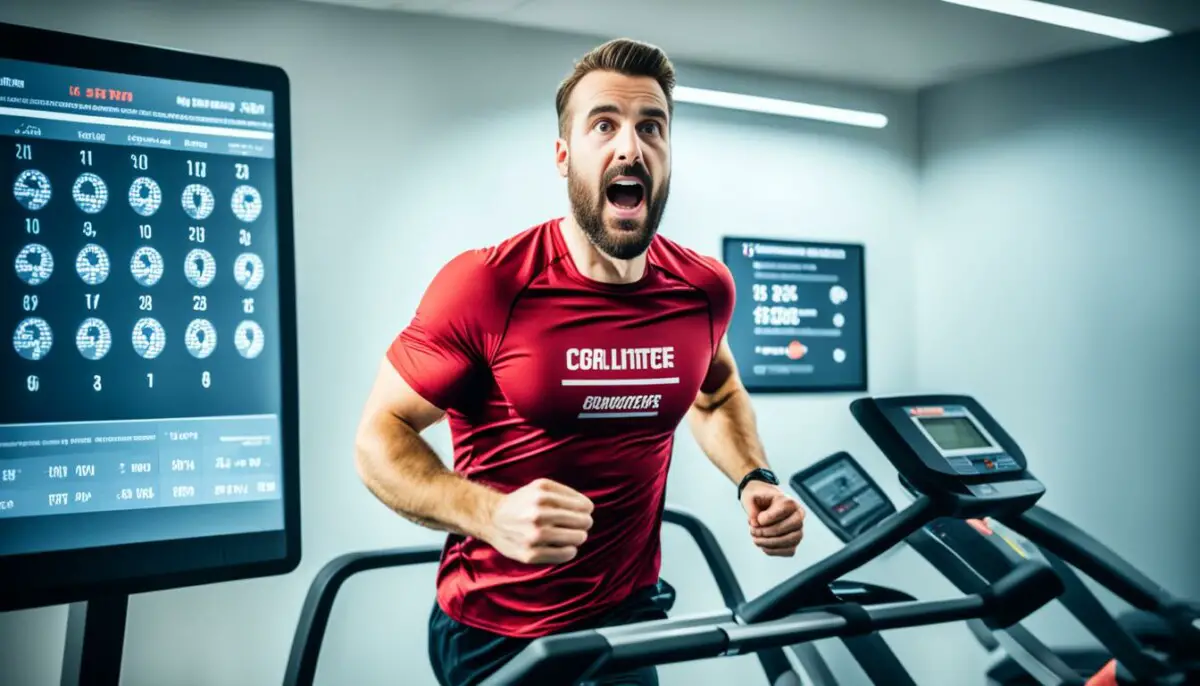Last Updated on 3 months by Francis
Treadmills are a common choice for individuals looking to track their workouts and monitor their progress. However, the accuracy of treadmills in providing precise measurements has been a subject of debate. While they offer valuable data on distance, speed, pace, and calories burned, it’s essential to understand the factors that can influence the accuracy of these measurements.
Factors such as belt wear and tear, the age of the treadmill, and input inaccuracies can impact the reliability of the data provided by treadmills. These factors can introduce slight variations, resulting in potential discrepancies between the displayed metrics and the actual workout performance.
Despite these limitations, treadmills are still a valuable tool for tracking workouts and setting fitness goals. By understanding their accuracy and considering the potential variations, individuals can utilize treadmill data as a general estimate to aid in their fitness journey.
In this article, we will explore the accuracy of treadmills in tracking workouts and assess their reliability. We will delve into how treadmills measure distance, discuss the accuracy of other metrics provided by treadmills, compare treadmill accuracy to other tracking methods, and examine the factors that influence calorie burn on treadmills. By the end, you will have a comprehensive understanding of the accuracy of treadmills and be equipped with valuable insights to make the most of your workouts.
Contents
Key Takeaways:
- Treadmill accuracy can be affected by factors such as belt wear and tear, age of the treadmill, and input inaccuracies.
- Despite potential variations, treadmills still provide valuable data for tracking workouts and setting fitness goals.
- Understanding the accuracy of treadmills can help individuals use the data as a general estimate rather than relying on it as an exact measurement.
- We will explore various aspects of treadmill accuracy, including distance measurement, accuracy of other metrics, and comparisons to other tracking methods.
- Factors such as fitness level, body composition, and running form can influence calorie burn on treadmills.
How Treadmills Measure Distance
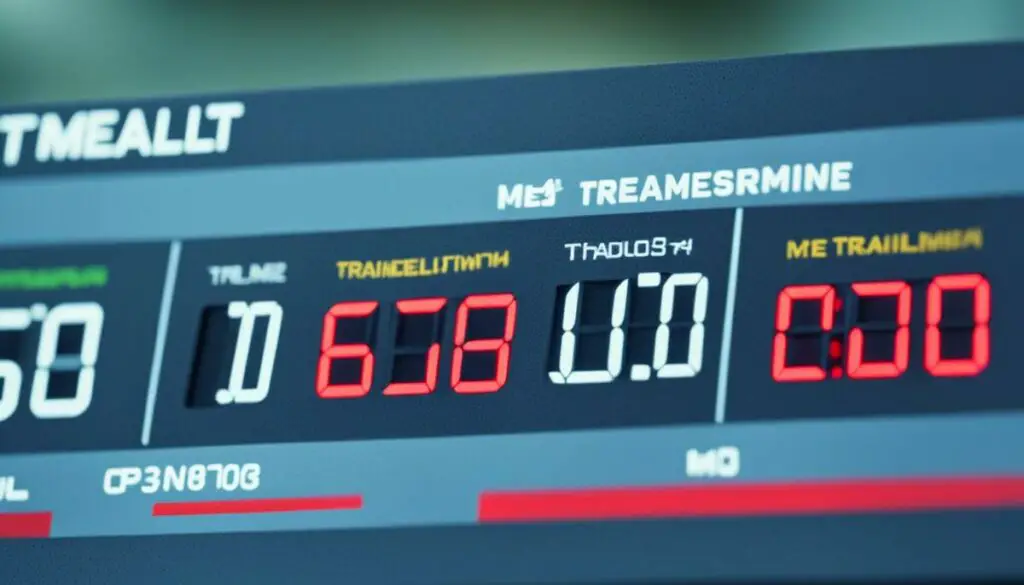
Treadmills are ingenious machines when it comes to tracking distance. They utilize a simple but effective method – counting the number of belt revolutions during a workout. Whether you’re walking, jogging, or sprinting, the treadmill tracks each revolution to accurately calculate the distance covered.
This distance measurement remains consistent regardless of your speed or incline settings. Whether you’re powering through a high-intensity interval workout or taking it easy with a brisk walk, the treadmill’s distance calculation method remains reliable and accurate.
However, it’s important to note that slight wear and tear on the belt over time, as well as the natural aging of the treadmill itself, can introduce minor inaccuracies. These factors can affect the precision of the distance measurement, but the overall accuracy of treadmills in measuring distance remains impressive.
| Treadmill Distance Measurement | Accuracy |
|---|---|
| Belt revolutions | High |
| Consistency across speeds and inclines | High |
| Effects of wear and tear | Slight inaccuracies possible |
With the treadmill’s reliable distance measurement capabilities, you can confidently track your progress and set distance-based goals for your workouts!
Accuracy of Other Metrics on Treadmills

While treadmills are commonly used for tracking workouts, it’s important to understand the accuracy of the various metrics they provide. While treadmills excel at measuring distance, other metrics such as speed, incline, and calories burned may be less precise.
Factors Affecting Accuracy
There are several factors that can impact the accuracy of these metrics. One significant factor is user input errors. Incorrectly entering weight, age, or other information can lead to inaccurate readings for metrics like calories burned. It’s essential to double-check data entry to ensure accuracy.
Sensor sensitivity is another factor to consider. Variations in sensor calibration and accuracy can affect the precision of metrics like speed and incline. Different treadmill models may have different sensitivity levels, leading to variations in readings.
Reliability of Treadmill Data
While treadmills provide valuable data for tracking workouts, the reliability of this data can vary. It’s essential to approach treadmill metrics as general estimates rather than exact measurements. Utilizing alternative tracking methods or cross-referencing data from different sources can provide a more comprehensive picture of your workout.
Comparison of Treadmill Metrics Accuracy
| Metric | Accuracy |
|---|---|
| Distance | High accuracy |
| Speed | Moderate accuracy |
| Incline | Moderate accuracy |
| Calories Burned | Low accuracy |
As seen in the table above, distance measurements tend to have high accuracy on treadmills. However, metrics like speed, incline, and calories burned have a moderate to low level of accuracy.
While treadmills can provide valuable insights into your workouts, it’s important to be aware of the limitations of their metrics. Consider using alternative tracking methods and cross-referencing data to ensure the most accurate and reliable information regarding your progress and performance.
Limitations of Treadmill Calorie Counts

Treadmill calorie counts are a common feature that many users rely on for tracking their fitness progress. However, it’s important to be aware of the limitations of these calorie counts and understand that they may not always be accurate or reliable.
One of the main factors that can affect the accuracy of treadmill calorie counts is individual differences. Every person has a unique physiology, including gender, age, height, weight, and body composition, which can impact the number of calories burned during a workout. Treadmills typically use generalized formulas to estimate calorie burn, but these formulas may not take into account the specific characteristics of each individual.
Additionally, factors such as fitness level and intensity of the workout can influence the accuracy of treadmill calorie counts. Someone who is more physically fit may burn calories more efficiently, resulting in a lower calorie count on the treadmill. On the other hand, individuals who are less fit may burn calories at a higher rate due to less efficiency in movement, leading to an overestimated calorie count.
“Treadmill calorie counts can provide a rough estimate, but it’s important to remember that they should not be taken as exact measurements.”
Another important consideration is the impact of body position and handrail usage on treadmill calorie counts. Holding onto the handrails of a treadmill can reduce the workload and make the workout easier, resulting in a higher calorie count being displayed. However, this may not accurately reflect the actual intensity of the workout.
While some treadmills are equipped with heart rate monitors to enhance accuracy, there are still variables that can influence the readings. Body position, movement, and certain medications can affect heart rate measurements, which in turn can impact the accuracy of the calorie count displayed on the treadmill.
It’s essential to approach treadmill calorie counts with caution and use them as a general estimate rather than an absolute measure of calorie burn. Remember that the reliability of these measurements is influenced by various factors, and they should be considered alongside other indicators of progress, such as overall fitness level, body composition changes, and personal energy levels.
In conclusion, while treadmill calorie counts can provide some insights into the intensity of a workout and estimated calorie burn, it’s important to recognize their limitations. Understanding the factors that affect their accuracy can help users make more informed decisions about their fitness goals and overall health.
Next, we’ll compare treadmill accuracy to other tracking methods, such as fitness watches and online calorie calculators, to help you determine the most reliable tools for monitoring your workouts.
Comparing Treadmill Accuracy to Other Tracking Methods
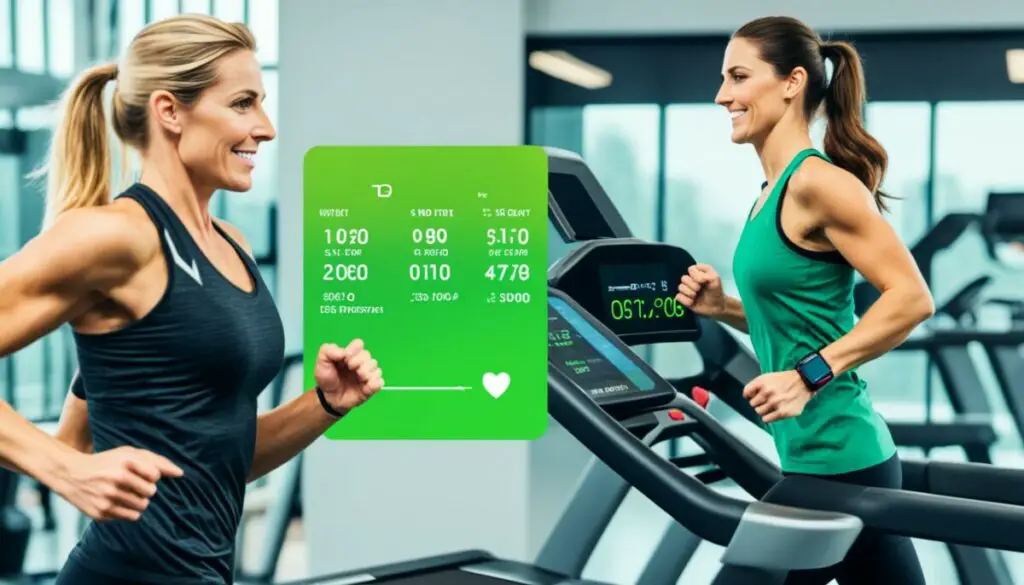
Treadmills have long been a popular tool for tracking workouts. However, when it comes to accuracy, they may not always be on par with other tracking methods such as fitness watches or wearable fitness trackers.
Fitness watches: These devices offer more personalized metrics and can take into account factors like heart rate and body composition. With advanced sensors and algorithms, fitness watches can provide a more accurate measurement of your workouts compared to treadmills. They can track a wide range of parameters including steps, distance, calories burned, heart rate, sleep quality, and even stress levels. From well-known brands like Fitbit and Apple Watch to specialized sports watches from Garmin and Polar, there are numerous options available to suit various fitness goals and budgets.
Wearable fitness trackers: Similar to fitness watches, wearable fitness trackers offer precise measurements and comprehensive tracking capabilities. These devices can be worn on your wrist, clipped to your clothing, or even attached to specific body parts for more accurate data collection during different types of workouts. With features like GPS tracking, heart rate monitoring, and advanced analytics, wearable fitness trackers provide a holistic view of your fitness activities. Popular brands in this space include Fitbit, Garmin, and Xiaomi, which offer a range of options to cater to different user preferences.
Online calorie calculators: While treadmills can estimate calorie burn based on distance and speed, online calorie calculators can provide more detailed estimates tailored to your specific profile. By inputting parameters such as your height, weight, age, and exercise intensity, these calculators use advanced algorithms to calculate calorie burn during a workout. They take into account factors that treadmills may overlook, such as individual body composition and metabolism. While not as immediate as real-time tracking, online calorie calculators can be a valuable tool for overall calorie management and goal setting.
It’s important to note that each tracking method has its own strengths and limitations. For example, while treadmills provide immediate feedback and a more immersive workout experience, they may not always offer the same level of accuracy as fitness watches or wearable fitness trackers. Ultimately, the choice of tracking method depends on your personal preferences and fitness goals.
| Tracking Method | Accuracy | Features |
|---|---|---|
| Fitness watches | High | – Heart rate monitoring – Sleep tracking – Advanced sensors and algorithms – Integration with smartphone apps |
| Wearable fitness trackers | High | – GPS tracking – Heart rate monitoring – Comprehensive workout analysis – Water and sweat resistance |
| Treadmills | Moderate | – Distance measurement – Speed and pace tracking – Incline adjustments – Calorie estimation |
| Online calorie calculators | Varies | – Customizable input parameters – Detailed estimates based on individual profile – Overall calorie management |
While treadmills can still provide valuable workout data, especially when it comes to distance, speed, and incline adjustments, fitness watches, wearable fitness trackers, and online calorie calculators offer a more comprehensive and accurate tracking experience. Consider your personal needs and preferences when choosing the right tracking method for your fitness journey.
Factors Influencing Calorie Burn on Treadmills
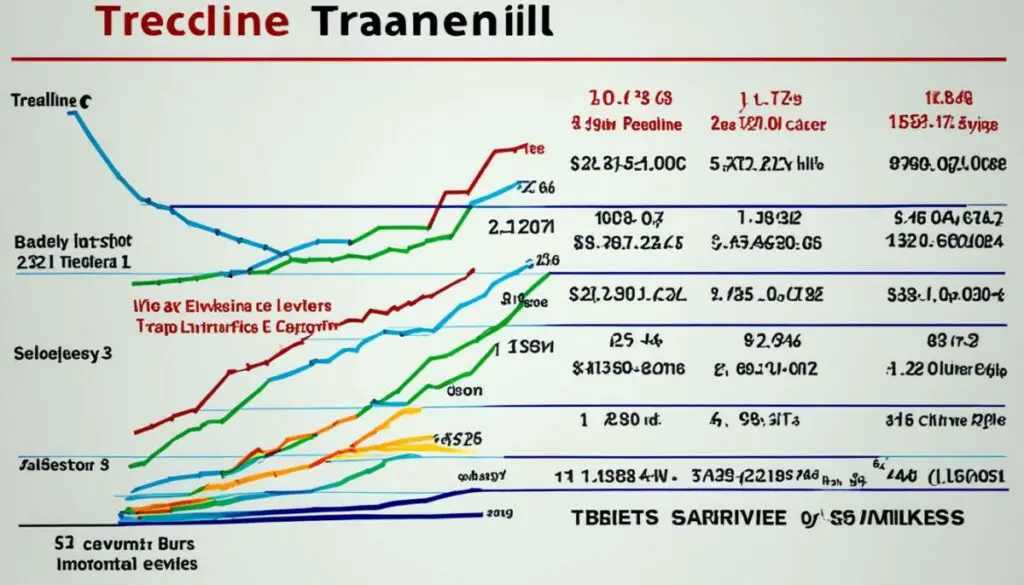
When it comes to calorie burn on treadmills, several factors come into play. These factors can influence the amount of calories burned during a workout session. Understanding these factors can help you make the most out of your treadmill workouts and reach your fitness goals. Here are the key factors that influence calorie burn on treadmills:
- Fitness level: Your fitness level plays a significant role in calorie burn on a treadmill. Beginners or individuals with a lower fitness level may burn more calories compared to those who are more experienced or have a higher fitness level. Less efficiency in movement and increased effort can result in higher calorie burn.
- Body composition: Body composition, including muscle mass and body fat percentage, affects calorie burn. Individuals with higher muscle mass and lower body fat tend to burn more calories during treadmill workouts. This is because muscle tissue requires more energy to maintain, resulting in an increased calorie burn.
- Body size: Body size, including height and weight, also plays a role in calorie burn on treadmills. Typically, individuals with a larger body size burn more calories due to the increased energy required to move a larger mass. However, it’s important to note that this may also result in a higher impact on the joints.
- Age: Age can impact calorie burn on treadmills as well. Generally, younger individuals may burn more calories compared to older individuals due to a higher metabolism. However, this difference may not be significant and can vary depending on individual factors.
It’s important to keep in mind that these factors interact with each other and individual variations exist. While fitness level, body composition, body size, and age can influence calorie burn on treadmills, it’s essential to listen to your body and focus on overall health and wellbeing. Consider consulting with a fitness professional to develop a personalized treadmill workout plan that aligns with your specific goals and needs.
Variability in Accuracy Across Cardio Machines
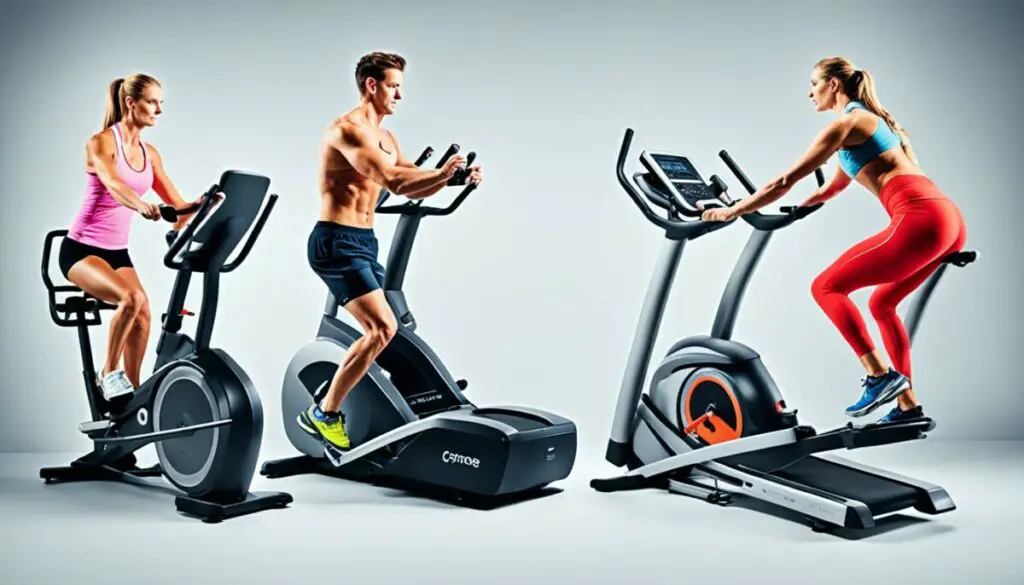
When it comes to tracking calorie counts, cardio machines such as treadmills, ellipticals, and stationary bikes can vary in accuracy. Factors like freedom of movement and calibration play a significant role in the reliability of these measurements.
Among cardio machines, stationary bikes tend to have more accurate calorie counters compared to treadmills and stair steppers. This is because stationary bikes provide a more controlled and stable environment for tracking workouts.
However, it is important to note that even though stationary bikes may offer more accurate calorie counts, individual results may still vary. Factors like age, weight, metabolism, and fitness level can influence the accuracy of the measurements.
To give you a better understanding of the variability in accuracy across different cardio machines, here is a table showing the average percent deviation in calorie counts compared to a gold standard measurement:
| Cardio Machine | Average Percent Deviation |
|---|---|
| Treadmill | ±10% |
| Elliptical | ±15% |
| Stationary Bike | ±5% |
As you can see from the table, treadmills and ellipticals tend to have a slightly higher variability in accuracy compared to stationary bikes. This means that the calorie counts provided by these machines may deviate by up to 10% and 15%, respectively, from the actual value.
Understanding the variability in accuracy across different cardio machines can help you make more informed decisions when tracking your workouts and calorie burn. It’s always a good idea to use these measurements as a general estimate rather than relying on them as absolute values.
Additional Factors Affecting Treadmill Accuracy
While factors such as belt wear, user input errors, and overall treadmill condition can impact accuracy, there are additional factors that can affect the precision of treadmill measurements. In this section, we’ll explore the impact of running form and handrail usage on treadmill accuracy.
Impact of Running Form
Your running form plays a crucial role in the accuracy of treadmill measurements. Inefficient running form, especially for beginners, can lead to an overestimated calorie burn. When your running form is inefficient, you may have excessive body movements and a higher energy expenditure, making it seem like you’re burning more calories than you actually are. It’s important to develop proper running form to ensure accurate measurements.
“It’s important to develop proper running form to ensure accurate measurements.”
Here are a few tips to improve your running form:
- Maintain an upright posture with your head aligned with your spine.
- Engage your core muscles to support your body and maintain stability.
- Keep your arms relaxed and swing them naturally, avoiding excessive movements.
- Land softly on your midfoot and avoid heavy, stomping steps.
- Maintain a consistent stride length and avoid overstriding.
Influence of Handrail Usage
Holding onto the handrails while using a treadmill can significantly impact the accuracy of calorie burn measurements. When you rely on the handrails for support, you reduce the workload on your lower body, leading to an overestimation of calorie burn. This is because the treadmill assumes that you are supporting your body weight entirely, resulting in inaccurate calorie calculations.
It’s important to resist the temptation of using the handrails excessively. While it may seem like a convenient way to steady yourself, it compromises the accuracy of your workout data. Instead, focus on developing proper balance and stability without relying on the handrails.
In summary, both running form and handrail usage can influence the accuracy of treadmill measurements. Inefficient running form can lead to an overestimated calorie burn, while excessive handrail usage can result in an inaccurate representation of your workout intensity. By improving your running form and avoiding handrail dependency, you can ensure more reliable and accurate treadmill data.
Understanding the Formulas Used by Treadmills
Treadmills rely on specific formulas to calculate calorie burn during workouts. These formulas are based on the concept of Metabolic Equivalent of Task (MET), which measures the amount of energy expended during physical activity. By considering factors such as speed, incline, and distance, treadmills estimate the number of calories burned.
It’s important to note that the accuracy of these formulas can vary across different treadmill manufacturers. Each brand may use its own algorithm, resulting in slight differences in calorie calculations. Additionally, these formulas do not take into account individual factors such as body composition or other physiological differences.
Despite these limitations, treadmill formulas provide a valuable estimate of calorie burn and can be used as a benchmark for tracking workouts. They offer a standardized measurement that allows users to compare their efforts across different sessions.
Here is an example of a typical MET table used by treadmills:
| Treadmill Speed (mph) | Treadmill Incline (%) | MET Value |
|---|---|---|
| 2 | 0 | 3.5 |
| 4 | 0 | 5 |
| 6 | 0 | 7 |
| 8 | 0 | 8.3 |
| 2 | 5 | 5.2 |
| 4 | 5 | 7 |
| 6 | 5 | 9.5 |
| 8 | 5 | 11 |
These values represent the average metabolic rate for different treadmill settings. By multiplying the MET value with a user’s weight, treadmills can estimate calorie burn.
While treadmill formulas provide a useful tool for tracking workouts, it’s essential to remember that they serve as estimates and may not reflect exact calorie expenditure. Individual variations and factors such as running efficiency or stride length can impact the actual number of calories burned.
Regular calibration and maintenance of treadmills can help improve accuracy and ensure consistent measurements. Additionally, combining treadmill data with other tracking methods, such as heart rate monitors or wearable fitness devices, can offer a more comprehensive understanding of workout intensity and calorie burn.
Conclusion
After examining the accuracy of treadmills for tracking workouts, it is clear that while they can provide valuable data, they are not always perfect in their measurements. Factors such as belt wear and tear, user input errors, and individual physiology can introduce variations and affect the precision of the data provided by treadmills.
Therefore, it is essential to approach treadmill data as a general estimate rather than an exact measurement. Treadmills can still serve as useful tools for monitoring progress and staying motivated, but it’s crucial to consider their limitations. Using additional tracking methods, such as fitness watches or wearable fitness trackers, can provide a more personalized and reliable analysis of your workouts.
Ultimately, the accuracy of tracking workouts with treadmills depends on various factors. It’s important to understand that no tracking method is perfect, but combining multiple sources of data can enhance the overall accuracy and provide a more comprehensive understanding of your fitness journey. By keeping these considerations in mind, you can make the most of your treadmill workouts and continue to achieve your fitness goals.
FAQ
Are treadmills accurate for tracking workouts?
Treadmills can provide data on distance, speed, pace, and calories burned, but their accuracy is influenced by factors such as belt wear and tear, age of the treadmill, and input inaccuracies.
How do treadmills measure distance?
Treadmills calculate distance by counting the number of revolutions the belt completes during a workout, which remains consistent regardless of speed or incline.
How accurate are other metrics on treadmills?
Metrics such as speed, incline, and calories burned may be less accurate than distance due to factors like user input errors and variations in sensor sensitivity.
What are the limitations of treadmill calorie counts?
Treadmill calorie counts are not always reliable due to individual differences in factors such as gender, age, height, weight, body composition, and fitness level.
How does treadmill accuracy compare to other tracking methods?
Treadmill accuracy may not be on par with fitness watches, wearable fitness trackers, and online calorie calculators that offer more personalized metrics based on factors like heart rate and body composition.
What factors influence calorie burn on treadmills?
Factors such as fitness level, body composition, body size, and age can influence calorie burn on treadmills. Beginners and individuals with more muscle mass and lower body fat may burn more calories.
How does accuracy vary across different cardio machines?
Calorie counts on cardio machines, including treadmills, ellipticals, and stationary bikes, can vary in accuracy. Stationary bikes tend to have more accurate calorie counters compared to treadmills and stair steppers.
What are some additional factors affecting treadmill accuracy?
Factors such as running form and handrail usage can affect treadmill accuracy. Inefficient running form and holding onto the handrails may lead to overestimated calorie burn.
How do treadmills use formulas to calculate measurements?
Treadmills use formulas based on the Metabolic Equivalent of Task (MET) to calculate measurements such as calorie burn. However, the accuracy of these formulas can vary across manufacturers and may not consider individual factors.

